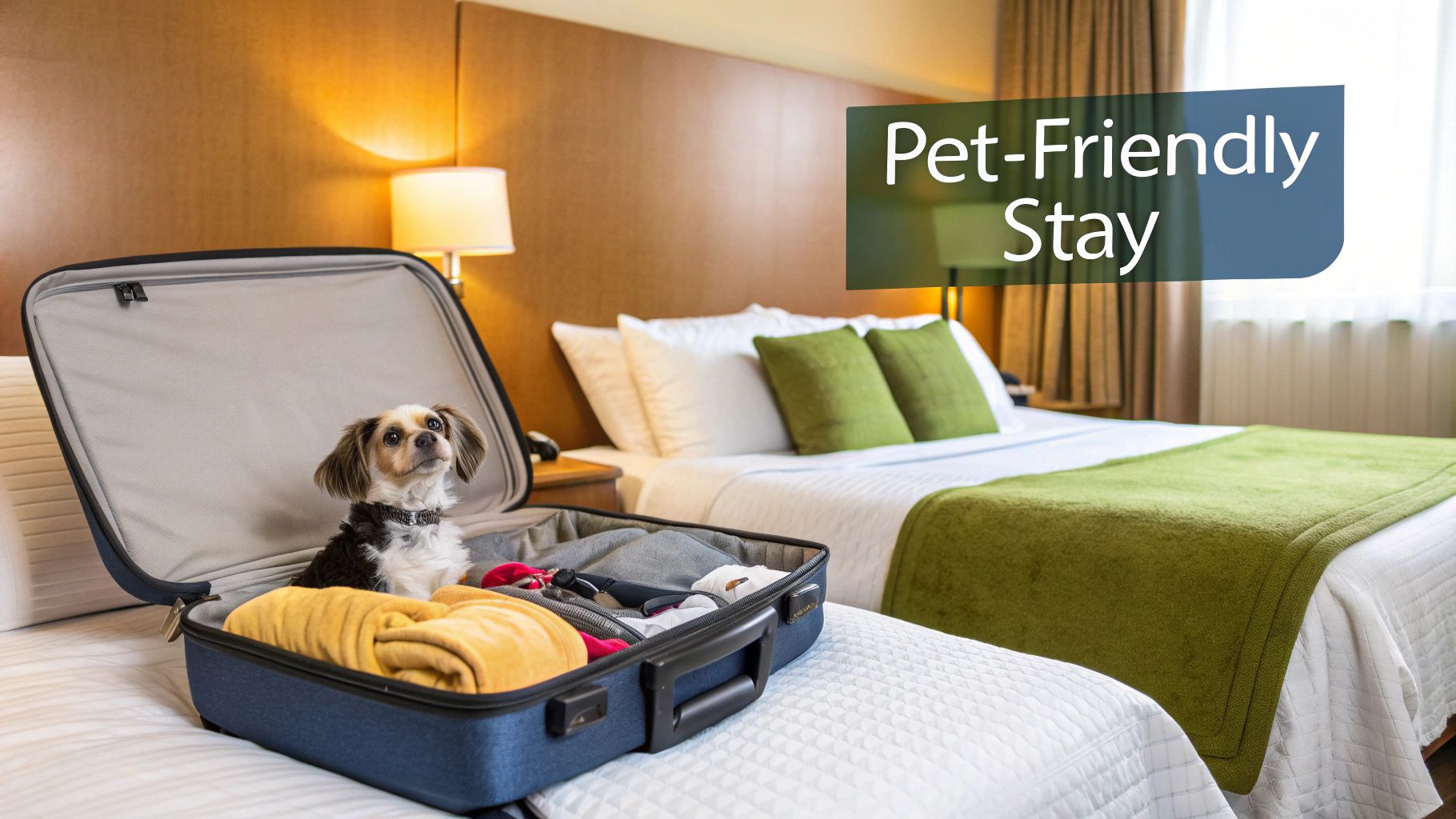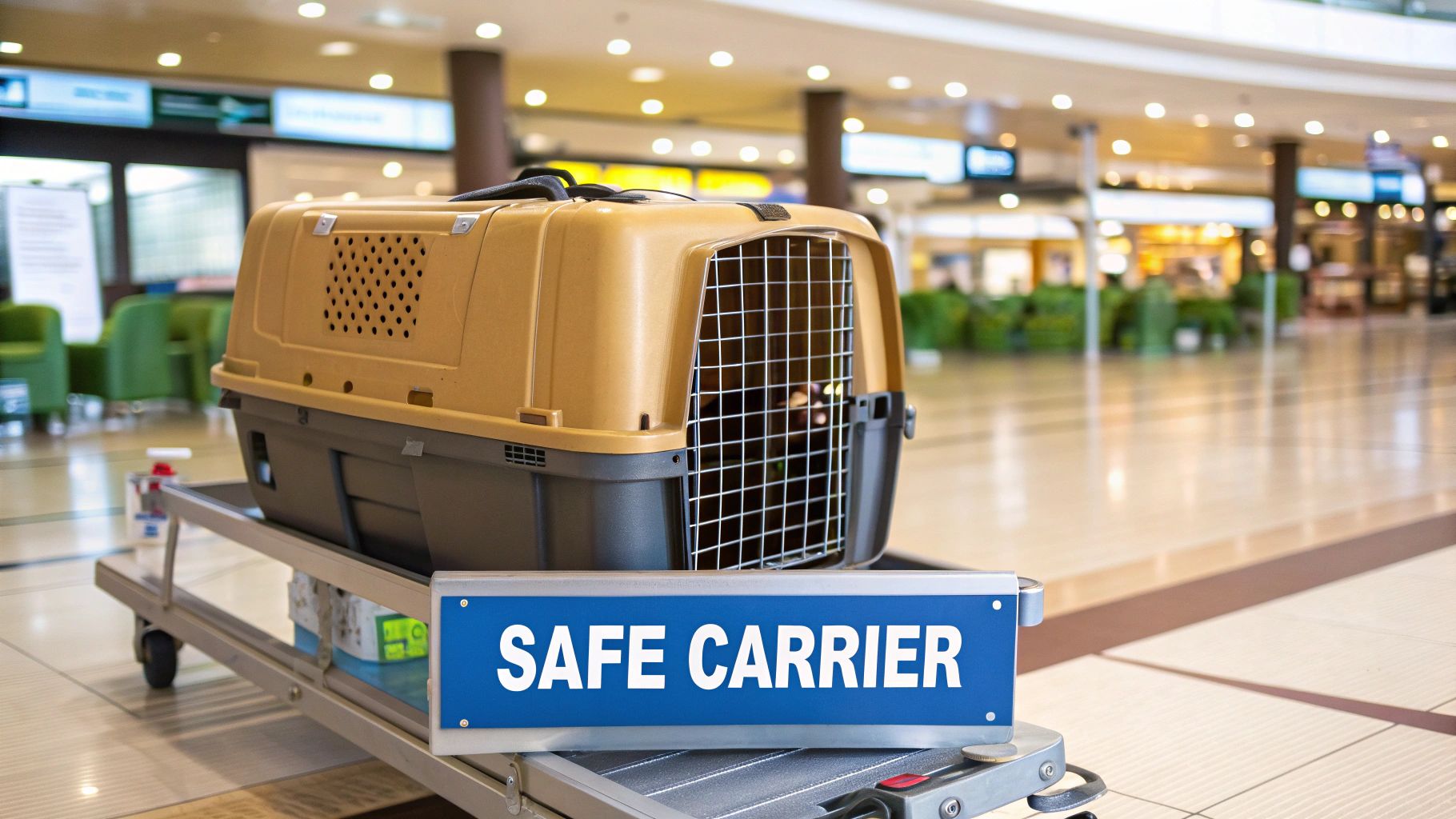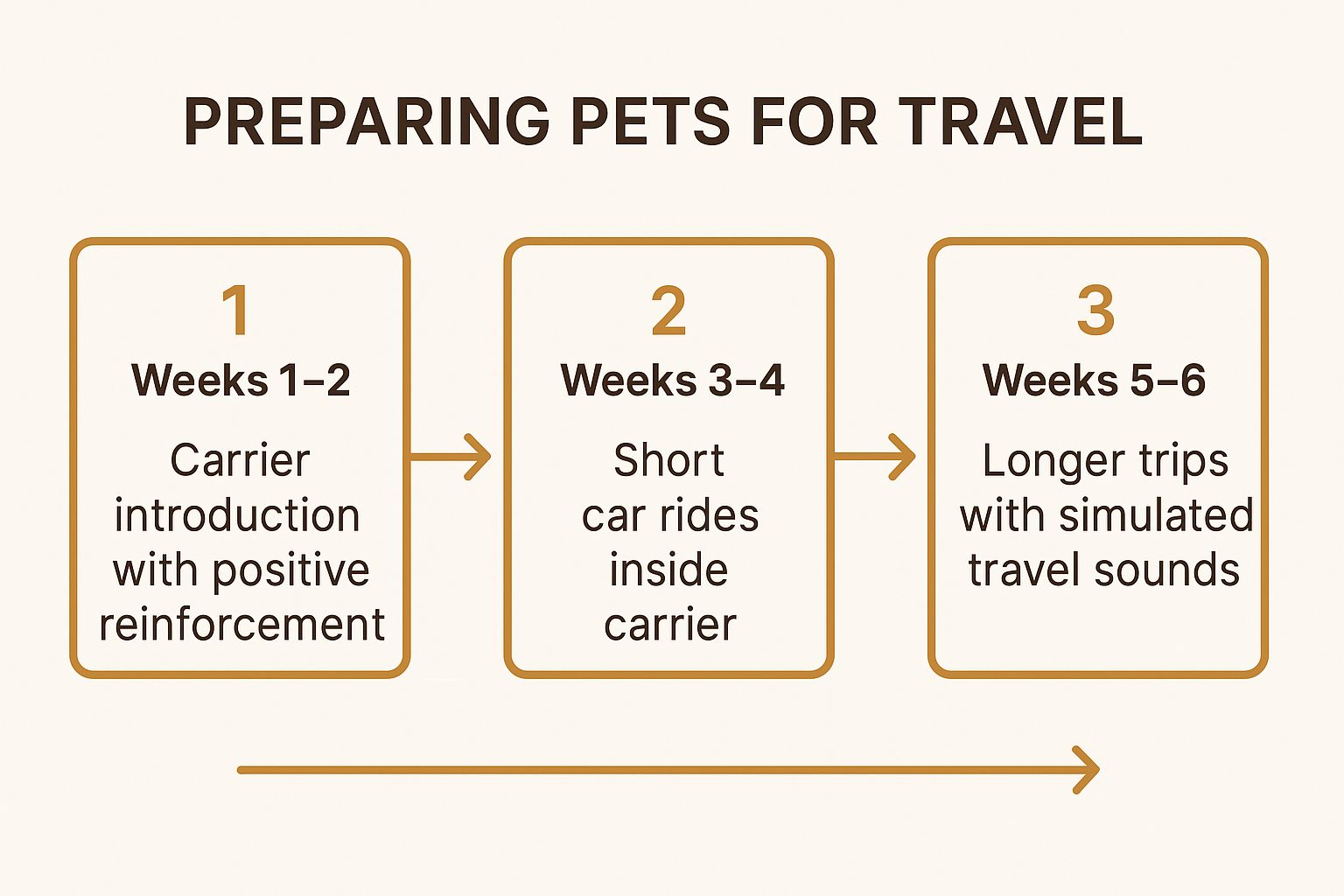Traveling with your furry friend can transform a good trip into an unforgettable one, but it requires meticulous preparation to ensure everything goes smoothly. Whether you're planning a scenic cross-country road trip or preparing for an international flight, your pet's safety, comfort, and well-being are the top priorities. This comprehensive guide moves beyond generic advice to provide seven essential, actionable traveling with pets tips, equipping you with the detailed strategies needed for a seamless journey.
We will break down the entire process step-by-step, covering critical tasks from navigating complex airline policies and securing genuinely pet-friendly accommodations to assembling the perfect travel kit packed with essentials and non-obvious items. You'll learn how to properly acclimate your pet to their carrier, gather the correct health documentation to avoid last-minute issues, and establish a solid emergency plan for peace of mind.
Each tip is designed to be practical and easy to implement, ensuring you and your companion are fully prepared for the adventure ahead. With these expert insights, you can avoid common pitfalls and focus on what truly matters: creating lasting memories while exploring the world together, stress-free.
1. Plan and Book Pet-Friendly Accommodations in Advance
One of the most critical traveling with pets tips is to secure your lodging well before you even think about packing. Unlike standard bookings, finding a welcoming place for your furry companion requires extra diligence, as many establishments have a limited number of pet-designated rooms. Procrastination can lead to last-minute scrambles, limited options, and unnecessary stress for both you and your pet.
Securing accommodations early ensures you find a place that doesn't just tolerate pets but truly welcomes them. This involves researching hotel policies, potential fees, and any restrictions on size, breed, or the number of animals allowed.

Why Early Booking is Non-Negotiable
Booking in advance transitions your trip from a potential headache to a planned adventure. It gives you the peace of mind that a comfortable, safe space is waiting for your entire family upon arrival. This proactive approach is essential for any successful journey, especially when planning the perfect pet-friendly road trip. For more insights on this topic, check out our guide to a successful pet-friendly road trip.
Actionable Steps for Securing Lodging
To ensure a smooth check-in and a pleasant stay, follow these practical steps:
- Call Directly: Never rely solely on a hotel’s website. Call the front desk directly to confirm their pet policy, ask about specific fees, and verify the availability of pet-friendly rooms. This also gives you a chance to ask about specific amenities.
- Investigate Restrictions: Inquire about any weight limits or breed restrictions. Many hotels have these in place, and discovering them upon arrival can derail your plans.
- Request Strategic Rooms: Ask for a ground-floor room near an exit. This simple request makes late-night and early-morning bathroom breaks significantly easier and less disruptive to other guests.
- Read Recent Reviews: Use platforms like BringFido.com or GoPetFriendly.com to read reviews from other pet owners. Their recent experiences can provide invaluable insights into how a hotel actually treats its four-legged guests.
- Confirm Local Amenities: Ask the hotel staff about nearby green spaces, walking trails, or dog parks. Knowing where your pet can safely stretch their legs and play is a huge plus.
Key Insight: Many hotel chains have standardized pet policies, but rules can vary by individual franchise location. Always confirm the policy with the specific hotel you plan to visit before finalizing your booking.
2. Ensure Proper Health Documentation and Veterinary Records
Just as important as your own passport and ID, your pet's health documentation is a non-negotiable component of travel. Keeping current health certificates, vaccination records, and other veterinary paperwork in order is crucial, especially when traveling across state lines or internationally. This preparation ensures compliance with legal requirements and safeguards your pet's health.
Failing to have the correct documents can lead to your pet being denied boarding on a flight, turned away at a border, or even placed in quarantine. Proper documentation is a fundamental part of responsible pet ownership and one of the most vital traveling with pets tips to guarantee a smooth, hassle-free journey.
Why Proper Documentation is Essential
Organizing your pet’s health records is a proactive step that prevents logistical nightmares. Different destinations have varying rules; for example, airlines like Delta often require a health certificate dated within 10 days of travel, while destinations like Hawaii enforce strict pre-arrival protocols to avoid quarantine. Being prepared demonstrates that your pet is healthy and poses no risk to other animals or people.
Actionable Steps for Managing Pet Records
To ensure you have everything in order before you depart, follow these practical steps:
- Schedule a Vet Visit: Book an appointment with your veterinarian 2 to 4 weeks before your trip. This allows ample time to update vaccinations and obtain a signed Certificate of Veterinary Inspection (CVI), or health certificate.
- Research Destination Requirements: Laws vary significantly by state and country. Use the USDA APHIS website for specific entry requirements for your destination, whether domestic or international. For instance, traveling to the European Union requires an EU-style pet passport.
- Keep Digital and Physical Copies: Store photos of all documents on your phone and in a cloud service. However, always carry the original physical copies with you in a waterproof folder, as many officials require them.
- Verify Microchip Information: Ensure your pet’s microchip is registered with your current contact information. A quick call to the microchip company or a check online can confirm the details are up-to-date.
- Check Vaccination Timelines: Some destinations require vaccinations to be administered a specific number of days before arrival. Confirm these timelines with your vet to ensure compliance.
Key Insight: A health certificate is a time-sensitive document. Most airlines and states require it to be issued within a specific timeframe (often 10-30 days) before your travel date. Always verify the validity period required by your airline and destination.
3. Choose the Right Travel Carrier and Ensure Proper Fit
Selecting the right travel carrier is one of the most fundamental traveling with pets tips, as it directly impacts your pet's safety and comfort. An appropriate carrier is not just a container; it's a secure, personal space for your animal during the stress of transit. The right choice depends on your mode of travel, your pet’s size, and temperament.
Whether you're flying or driving, the carrier must provide adequate ventilation and enough room for your pet to stand up, turn around, and lie down comfortably. A carrier that is too small can cause distress and physical discomfort, while one that is too large may not provide a sense of security during movement.

Why the Right Carrier is Non-Negotiable
A well-chosen and properly fitted carrier is crucial for compliance with airline regulations and for your pet's overall well-being. For air travel, carriers like the Petmate Sky Kennel are industry standards for cargo, while soft-sided options such as the Sherpa Original Deluxe Carrier are popular for in-cabin travel. Using the correct carrier prevents last-minute denials at the airport and ensures your pet remains safe throughout the journey.
Actionable Steps for Selecting and Preparing the Carrier
To guarantee a safe and comfortable experience, follow these practical steps:
- Measure Your Pet: Before buying, measure your pet’s height (from floor to top of head/ears) and length (from base of tail to tip of nose). Compare these measurements against the carrier’s interior dimensions and the airline’s specific size limits.
- Introduce It Early: Bring the carrier into your home several weeks before your trip. Leave the door open and place treats, familiar toys, and soft bedding inside to create a positive association.
- Practice Short Trips: Start with short car rides to help your pet acclimate to the motion and confinement of the carrier. This reduces the anxiety associated with being enclosed during a longer journey.
- Label Extensively: Attach multiple labels to the carrier with your name, phone number, destination address, and emergency contact information. Include a "Live Animal" sticker with arrows indicating the upright position.
- Check Airline Rules: If flying, visit the airline’s website or call to confirm their exact carrier requirements. Each airline has slightly different rules for in-cabin and cargo transport, and non-compliance can lead to being denied boarding.
For a visual guide on how to choose the right carrier, this video offers excellent advice:
Key Insight: The goal is to make the carrier a safe haven, not a source of fear. Positive reinforcement and early familiarization are the keys to helping your pet see their carrier as a comfortable, mobile den rather than a cage.
4. Pack a Comprehensive Pet Travel Kit
One of the most essential traveling with pets tips is to assemble a dedicated, well-organized travel kit for your companion. This goes beyond just grabbing a bag of food; it's about creating a comprehensive collection of supplies that ensures your pet's comfort, health, and safety on the road. A thoughtfully packed kit prepares you for routine needs, unexpected delays, and potential emergencies, allowing you to focus on enjoying the journey.
Being prepared with a pet-specific bag means you won't be scrambling to find a pet store in an unfamiliar town or dealing with an anxious animal who lacks their favorite comfort items. This proactive step is crucial for a smooth and stress-free travel experience, whether you're on a quick weekend getaway or a cross-country adventure.

Why a Dedicated Kit is Non-Negotiable
A well-stocked kit is your pet's lifeline during travel, providing consistency and security in a new environment. It centralizes all their essentials, making it easy to access food, water, medications, and waste bags at a moment's notice. This preparation is a cornerstone of responsible pet ownership and a key element of any successful trip.
Actionable Steps for Assembling Your Kit
To ensure you have everything your pet might need, use this checklist as a guide:
- Pack Extra Food and Water: Always bring at least three extra days' worth of your pet's regular food to account for travel delays. To prevent digestive issues, pack bottled water from home or a portable water filter.
- Organize Medications and Documents: Keep all medications in their original, clearly labeled containers. Include a copy of your pet's vaccination records, a recent photo of them, and your vet's contact information in a waterproof bag.
- Include Comfort Items: A familiar blanket, bed, or favorite toy that carries the scent of home can significantly reduce travel anxiety. These items create a sense of normalcy and security for your pet in a new setting.
- Prioritize a First-Aid Kit: Purchase a pre-made pet first-aid kit or build your own with essentials like antiseptic wipes, gauze, self-adhesive bandages, and any pet-specific medications recommended by your veterinarian.
- Don't Forget Cleanup Supplies: Pack more poop bags than you think you'll need, along with paper towels and pet-safe cleaning spray for any potential accidents in the car or your accommodation.
Key Insight: Tailor your kit to your mode of transport. For air travel, focus on airline-approved carriers, collapsible bowls, and absorbent pads. For road trips, include a car seat cover, a safety harness or crate, and window shades to keep your pet cool.
5. Research Pet Policies for Transportation Methods
Just as you would for accommodations, thoroughly investigating the pet policies of your chosen transportation method is a non-negotiable step. Whether you're flying, taking a train, or renting a car, each company has its own set of rules, fees, and restrictions that can significantly impact your travel plans. Overlooking these details can lead to denied boarding or unexpected charges on your travel day.
Understanding these policies in advance is one of the most crucial traveling with pets tips because it ensures you meet all requirements, from carrier dimensions to health documentation. This due diligence prevents stressful surprises and guarantees a smoother journey for everyone involved.
Why Policy Research is Non-Negotiable
Failing to verify transportation rules can completely derail your trip. For instance, airlines have a limited number of pet spots per flight, Amtrak requires advance pet reservations on specific routes, and many car rental companies impose cleaning fees. Proactive research ensures you can book the necessary space for your pet and budget for any associated costs, avoiding last-minute crises. To dive deeper into the specifics of air travel, explore our guide on how to fly with pets.
Actionable Steps for Transportation Planning
To ensure your pet is cleared for travel, follow these practical steps:
- Confirm Directly with the Carrier: Call the airline, train line, or rental car company directly. Website information can be outdated, and a direct conversation allows you to ask specific questions and confirm the most current policies.
- Book Your Pet’s Spot Immediately: Pet spots are often limited. As soon as you book your own ticket, book your pet’s reservation. Do not assume you can add them later.
- Clarify Carrier Requirements: Ask for specific dimensions and type of carrier allowed (hard-sided vs. soft-sided). For air travel, confirm if the carrier is for in-cabin or cargo transport, as the rules differ significantly.
- Inquire About Fees and Deposits: Understand all costs upfront. Airlines like Southwest charge a per-way pet fare, while rental car companies may require a non-refundable cleaning fee or a refundable damage deposit.
- Review Health Documentation Rules: Check what health certificates or vaccination records are required. This is especially important for air travel and crossing state or international borders, as requirements can be very strict.
Key Insight: Policies often distinguish between pets and service animals. Be clear about your situation when making inquiries, as the rules, rights, and required documentation are entirely different. Assuming pet policies apply to a service animal (or vice versa) can lead to major issues.
6. Prepare Your Pet for Travel Through Gradual Training
One of the most impactful traveling with pets tips is to address the journey long before it begins. Instead of springing a stressful new environment on your pet, you can use gradual training to acclimate them to the sights, sounds, and feelings of travel. This process of desensitization, recommended by animal behaviorists, transforms a potentially terrifying experience into a familiar and manageable one.
This proactive conditioning significantly reduces travel anxiety and prevents behavioral issues. By starting weeks in advance, you can build your pet’s confidence through short, positive experiences, making the actual travel day far less intimidating for everyone involved.
The infographic below outlines a simple, step-by-step process for gradually preparing your pet for travel.

This structured timeline visualizes how to build positive associations over several weeks, starting with the carrier and progressing to simulated travel scenarios.
Why Gradual Training is Essential
Jumping directly into a long car ride or flight can overwhelm a pet's senses, leading to fear and anxiety. Gradual exposure allows their nervous system to adapt slowly, creating a foundation of safety and trust. This method is particularly crucial for animals prone to motion sickness or anxiety. For more in-depth techniques, explore our guide on soothing strategies for a dog anxious in car journeys.
Actionable Steps for Travel Conditioning
Follow this structured approach to set your pet up for a successful and calm journey:
- Introduce the Carrier Early: Place the carrier in your living area weeks before your trip. Make it a comfortable den with familiar blankets and toys. Encourage exploration by placing high-value treats and meals inside, ensuring it becomes a positive space.
- Start with Short Car Rides: Once your pet is comfortable in the carrier, begin with short, five-minute car rides around the block that end with a reward. Gradually increase the duration as their comfort level grows.
- Simulate Travel Sounds: For air travel, play quiet recordings of airplane cabin noise during feeding or playtime. This helps desensitize them to the unfamiliar sounds they will encounter on the plane.
- Use Positive Reinforcement: Never force your pet into a situation. Rely exclusively on praise, toys, and high-value treats to create positive associations with every step of the training process.
- Consider Calming Aids: Discuss options like pheromone sprays (e.g., Feliway or Adaptil), calming supplements, or, in severe cases, anti-anxiety medication with your veterinarian.
Key Insight: Consistency is more important than duration. A few positive five-minute sessions each week are far more effective than one stressful hour-long session. Always end on a positive note before your pet shows signs of stress.
7. Establish Emergency Preparedness and Veterinary Contingency Plans
While no one wants to imagine an emergency, being prepared is one of the most responsible traveling with pets tips you can follow. A solid contingency plan ensures you can act swiftly and effectively if your pet becomes ill or injured on the road, minimizing panic and providing them with the best possible care. This proactive measure involves more than just packing a first-aid kit; it's about creating a safety net for your pet away from home.
Having a plan ready means you've already done the critical thinking before a crisis occurs. It allows you to focus entirely on your pet's needs instead of scrambling to find a vet in an unfamiliar area, potentially wasting precious time.
Why a Contingency Plan is Non-Negotiable
A well-researched emergency plan transforms a potential travel disaster into a manageable situation. Knowing who to call and where to go provides invaluable peace of mind, allowing you to enjoy your trip more fully. Companies like the Veterinary Emergency and Critical Care Society promote this level of preparedness, highlighting its importance for any pet owner venturing away from their primary vet.
Actionable Steps for Emergency Preparedness
To build a robust safety plan for your pet, follow these practical steps:
- Pre-Scout Veterinarians: Before your trip, use apps like VetFinder or a simple Google Maps search to identify and save the contact information for 24-hour emergency veterinary hospitals along your route and at your destination. Note their hours and exact locations.
- Verify Insurance Coverage: Call your pet insurance provider, such as Trupanion or Nationwide, to confirm that your policy provides coverage in the areas you'll be visiting. Ask about the claims process while traveling to avoid surprises.
- Digitize Medical Records: Keep a digital copy of your pet’s complete medical records, including vaccination history and any chronic conditions, on your phone or in cloud storage. This allows any vet to quickly understand your pet's health history.
- Designate an Emergency Contact: Choose a trusted friend or family member who can make medical decisions for your pet if you are unreachable. Provide their contact information to your travel companions and keep it with your pet's documents.
- Pack a Pet First-Aid Kit: Include essentials like antiseptic wipes, gauze, self-adhering bandages, and any specific medications your pet needs. Knowing basic pet first aid can also be incredibly valuable.
Key Insight: Many national veterinary networks, such as VCA Animal Hospitals, have locations across the country, often with 24-hour emergency services. Familiarizing yourself with these networks can provide a reliable and consistent standard of care in unfamiliar territory.
7 Key Tips for Traveling with Pets Comparison
| Item | Implementation Complexity 🔄 | Resource Requirements ⚡ | Expected Outcomes 📊 | Ideal Use Cases 💡 | Key Advantages ⭐ |
|---|---|---|---|---|---|
| Plan and Book Pet-Friendly Accommodations in Advance | Moderate: requires research and early booking | Time for policy comparisons, potential deposits | Guaranteed lodging availability, less stress | Trips needing pet-friendly lodging early | Ensures stay availability, reduces travel stress |
| Ensure Proper Health Documentation and Veterinary Records | High: complex, time-sensitive paperwork | Veterinary visits, potential costs | Compliance with regulations, pet health safety | Interstate/international travel, airline trips | Prevents travel delays, ensures health safety |
| Choose the Right Travel Carrier and Ensure Proper Fit | Moderate: selection and training needed | Purchase of carrier, time for carrier training | Secure, comfortable transport for pet | Air travel, any transportation requiring carriers | Provides pet safety, reduces anxiety |
| Pack a Comprehensive Pet Travel Kit | Low to moderate: gathering supplies and organization | Purchase of food, meds, first aid items | Preparedness for emergencies and comfort | Any pet travel duration, especially long trips | Maintains pet routine, prepares for emergencies |
| Research Pet Policies for Transportation Methods | Moderate to high: requires extensive policy review | Time for research and booking | Avoids surprises, legal compliance | Multi-modal travel, unfamiliar transportation | Prevents travel complications, allows cost planning |
| Prepare Your Pet for Travel Through Gradual Training | High: requires weeks of consistent training | Time investment, possible trainer costs | Reduced pet anxiety and behavioral issues | Anxious pets, first-time travelers | Improves pet comfort, smoother travel experience |
| Establish Emergency Preparedness and Veterinary Contingency Plans | Moderate: planning and research required | Time for research, emergency supplies | Quick response to emergencies, peace of mind | Long trips, remote destinations | Enables emergency care, reduces travel risks |
Embark on Your Next Adventure with Confidence
Transforming a journey with your beloved pet from a source of anxiety into a collection of cherished memories hinges on one critical element: thorough and thoughtful preparation. The road to a successful trip isn't paved with luck, but with the deliberate, actionable steps you've just explored. By embracing these detailed traveling with pets tips, you are no longer just a pet owner; you are a proficient and confident travel companion for your furry, feathered, or scaled family member.
From Logistics to Lasting Memories
The strategies outlined in this guide serve as your comprehensive blueprint. You now understand that the journey begins long before you leave the house. It starts with meticulously researching and booking genuinely pet-friendly accommodations, not just places that tolerate pets. It continues with a proactive visit to your veterinarian to ensure all health documentation is current and accessible, a simple step that prevents significant travel-day headaches. The importance of selecting the perfect travel carrier, one that serves as a safe and comfortable den, cannot be overstated. A well-fitted carrier is the cornerstone of a secure travel experience for your pet.
Moreover, you are now equipped to assemble a comprehensive pet travel kit that anticipates every need, from familiar toys and bedding to essential first-aid supplies. This proactive packing transforms potential travel mishaps into minor, manageable inconveniences. Coupled with diligent research into airline or road trip policies and a solid emergency contingency plan, you have effectively created a safety net that allows both you and your pet to relax and enjoy the experience.
The True Value of Preparation
Mastering these concepts is about more than just checking items off a list. It’s about cultivating a deeper understanding of your pet's needs and temperament in a new environment. Gradual training and familiarization with their carrier or car harness build their confidence, turning the unknown into a positive and predictable event. This investment of time and effort pays dividends, strengthening the bond you share and ensuring that travel is a source of joy, not stress.
By proactively managing every detail, you are honoring the commitment you made to your pet's well-being. You are ensuring their safety, prioritizing their comfort, and setting the stage for unforgettable shared experiences. The peace of mind that comes from knowing you are fully prepared is invaluable. It frees you to focus on what truly matters: making incredible memories together, whether you're exploring a new hiking trail, visiting family across the country, or simply enjoying a change of scenery. Your adventure awaits, and with these expert traveling with pets tips in your arsenal, you are ready to embark with total confidence.
Ready to find the perfect travel gear to ensure your pet's safety and comfort? Explore the curated collection of premium carriers, travel bowls, and safety harnesses at Pet Voyages. We've done the research so you can shop with confidence, knowing every product is designed for a seamless journey. Visit Pet Voyages today and take the first step toward your next great adventure together.

